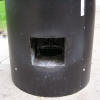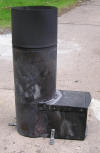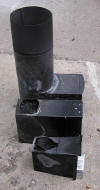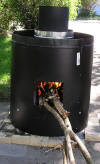An Experiment with a Rocket Stove - page 3
This is an experiment with a higher-heat design for possible institutional
use. It changes the way that air is injected into the wood fuel to simplify the
wood inlet chamber. It was made from four 8" diameter x 24", 24 gauge, black
vent pipes (About $6 each - Menards). The new wood fuel inlet is 6" wide and 7" tall. The fire
"chamber" is also 7" tall. The air inlet (On the back side) starts 1" off the
bottom and is 6" high by 9" wide. There is a hinged baffle hanging between the air inlet
and fire chamber. This makes the incoming air circulate around the hot ashes to
pre-heat the air. The chimney is 8" in diameter. The chimney height is 16" high.
The air opening leading into the fire chamber is 7" diameter. The diameter of
the shell is about 22", a little larger than the 21 1/2 " grille that I used.
The distance from the bottom of the stove to the top of the wood inlet is 14". This design
should hold up to about a 90-100 quart cook pot.
The test unit only consists of the core heating system. A bottom,
suitable-sized skirt with support, higher sides on the outer shell, and support
for a heavy cooking pot would need to be added. The insulating shield that
normally goes around the chimney and the fire chamber area in operation has been
left off for these pictures. The unit sat on fire bricks for the tests to seal
off the bottom. I originally tried to use a 10" chimney, but keeping the unit
smokeless was too difficult, so I added an extension to make it 16". A longer
chimney, 18"- 24" long, would be better but I was trying to keep a final stove
design that would end up below about four foot tall.




Pictures below show the firebox and chimney assy. removed from the shell. Three
"L" brackets are used to secure the heat section in place. The sheet metal under
the grille was made from a piece of 8" vent pipe. An 8" x 24" vent pipe will
give a 24" x 24" square with the mating edges cut off.


A size comparison of core heating units from all three test units.


These are some pictures of a test. The left picture is show with a chimney
extension, to make the chimney 16" high. The picture on the right is shown with
only a 10" chimney and the insulating shield removed.


From my testing I came up with a general guide for minimizing smoke
here.
Oct 1, 2007 - A full scale stove was built around this design and is
currently being tested at a school in central Tanzania. It was designed to
be flown overseas as checked baggage and then reassembled, in a few hours,
onsite. Assembled, it's outside diameter is 24", it stands 4 foot tall, and the
inner skirt around the pot is 22" diameter. The stove is bolted down to a
concrete slab to prevent tipping and steps were built on two sides to
allow the cooks easier access. The stove is to replace a large "three-stone"
fire that is used for cooking ugali, potatoes, beans, and rice. It is also being
used for pre-heating large quantities of water, since it is much more efficient
than the cook fires and puts out no smoke. The cook pot used with the stove is
about 21" diameter, 18" deep and can hold about 100 quarts. The water can then
be removed to other pots for cooking food with the present open fire method.
Heating water to boiling takes lots of energy and time, so this can greatly
reduce the time that cooks are exposed to smoke and the amount of wood that
needs to be gathered. The technology is close enough to their present cooking
methods and requirements, not complicated, and due to the simple design, should be reliable,
all of which I believe are keys to acceptance. The cooks began using it the day
after it was installed and are reportedly very pleased with it. If the design
proves successful, long term, the details will be posted here.
L.B.
NEXT PAGE
PREVIOUS PAGE
HOME PAGE









